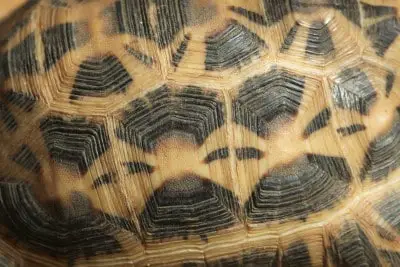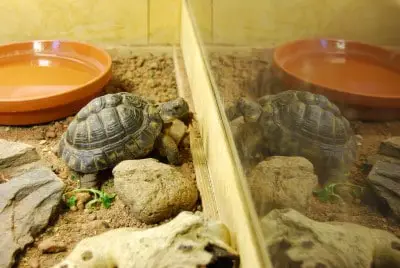You might have come across some people posting pictures of colorful tortoises with painted shells and shimmering glued-on pieces of jewelry. This must have had you wondering whether it is okay for you to paint your tortoise too. Although their bodies are of the same materials that make your nails, painting tortoises may not be a good idea.
We strongly advise against painting the tortoise because the paint contains harmful chemicals, which the armor shell can easily absorb, causing various health complications. The paint may also cover up the shell, blocking it from absorbing the sun rays, which are required for vitamin D synthesis.
With an alarming number of people showing off their painted pets, we aim to bust the myths surrounding the practice. Read on to understand the effects of painting your tortoise’s shell and alternative methods you can use to enhance your tortoise’s looks.

Can You Paint Your Tortoise?
Sadly, there are many cases of painted tortoises, both wild and domesticated. Some people find the shell an impressive canvas to show off their painting skills, while some do it innocently, not knowing about the harmful side effects. As it turns out, your decision to paint a tortoise’s shell may cost you its life.
It is a terrible idea to paint a tortoise’s shell. Paint is a lethal chemical whose fumes are known to be dangerous to humans. Prolonged exposure to these chemicals has several side effects and can even lead to loss of life.
Some may argue that the shell is made of keratin, which is also in the nails, and if nail polish cannot harm you, it will be of no consequence to the tortoise. In contrast, science has findings that frequent nail painting can expose you to several toxins, not only through the air but also through your nails! However, you cannot see the effects immediately because your nails are tiny compared to other organs. Therefore, tortoises feel the impact more than you do due to the size of their shells.
The shell covers a significant part of their bodies apart from the limbs and the head. Unlike you, painting a tortoise’s shell means that it will have up to eighty percent of its body dosed in lethal chemicals. It is so dangerous that some states have passed strict legislation against the painting of such endangered species.
Also, the tortoise’s shell is quite porous, enabling some materials to seep into it. The keratin has tiny pores, seen only under a microscope, and if it can easily allow air and nutrients to pass through, what of paint fumes?
Negative Effects of Painting a Tortoise’s Shell
If there were ways for the tortoise to express its feelings, it would undoubtedly be against being painted, whether in captivity or the wild. It is one of the slowest and surest ways to kill a tortoise. Painting a tortoise’s shell is like painting the human skin and will have the same effects.
Here are some of the negative effects of painting your tortoise’s shell.
Toxins
The paint contains harmful chemicals that easily seep through the shell. These chemicals can easily leak into the tortoise’s bloodstream, and the results are fatal. The signs will manifest as illnesses and will eventually cause death. Unknown to many, the keratin found in the shell allows the absorption of substances like sun rays, air, and vitamins.
It is also connected to numerous nerves and blood vessels, meaning that the chemicals will go directly into the tortoise’s bloodstream. Each chemical found in paint carries health hazards to any animal, and the effects are so dire that children and pregnant women are advised not to inhale it.
Health Issues
Chemicals, such as toluene and turpentine, which are found in paints, are harmful to animals. With prolonged exposure to such substances, the tortoise is at risk of acquiring life-threatening respiratory illnesses. The paint fumes’ smell is also irritating and can cause breathing problems; painting the tortoise’s entire shell is like locking someone in a freshly painted room causing them to constantly inhale the chemicals.
Sunblock
Tortoises often bask to obtain more vitamins from the sun, which brings us back to the argument that their shell is porous. Typically, paint is essential in shielding surfaces from the sun’s rays, and this is what it does to the tortoise.
Once you apply paint on it, you block it from absorbing the rays needed for nutrients. Gradually, it will suffer from vitamin deficiency and die, especially if there are no alternative sources.
Heat
Tortoises, like all reptiles, depend on external sources to help regulate their body heat. The only way for them to absorb or lose excess heat is through the shell.
Thus, if you paint it, you block all the pores needed for the release of heat. Therefore, if the heat becomes overwhelming, the tortoise will overheat and eventually die. Similarly, it will be difficult if it needs to absorb some heat when it gets cold.
Are Tortoise-Friendly Paints Safe?
Since it is evident that paint threatens tortoises’ life, many companies are now claiming sole production of healthy paint you can use on the shell. These paints are readily available in the market with various options. The only concern is whether they are a safe alternative to house paint.
“Tortoise-friendly” paints are not as safe as they may seem. If you paint the tortoise’s shell with any paint, even one without harmful chemicals, you will still block all the pores on the shell, consequently denying the tortoise a chance to absorb and synthesize the nutrients it needs.
For instance, it needs to absorb the sun’s rays for vitamin D necessary for healthy bones. Without it, your pet will suffer from weak bones and, in advanced stages, arthritis. Therefore, even without the chemicals, paint is still harmful to tortoises.
Other than sun rays absorption, the painting will also block air conditioning within the tortoise’s body. The reptile’s internal systems work tirelessly and produce a lot of heat that needs release. If not, the high temperatures will build up inside the animal’s body, overwhelming its systems and eventually kill it.
If you must paint your tortoise for whatever reason, it is wise to consult exotic animal experts for the best way to go. You can use small identification marks on the reptile’s body, if crucial, but only use the recommended paint. Regardless, we advise that you refrain from applying any on any part of your tortoise’s body.
Paints can compromise the health of any tortoise. However, there are alternatively certified paints that you can use, which the marine wildlife officers advise. For instance, marker paint is a safe option for your buddy. Other people may also argue that nail polish is also acceptable since we use it on our nails, which is made of keratin, the same substance found in a tortoise’s shell. The fact is, the chemicals in nail polish will easily leak into the armor through the tiny pores.
Alternatives To Painting the Tortoise
Having learned that paints are harmful to your pet, you may wish to know whether there are alternative ways to enhance your tortoise’s look. To keep your pet safe and make them look fancy at the same time, consider the few options you can deploy.
Tank Painting
When you decide to paint the reptile’s habitat, everything inside the enclosure, including the tortoise, will look fantastic. It also gives you the freedom to customize it however you like, knowing that you are not putting your pet’s life in danger.
In this case, you can use any paint, even those laced with chemicals. However, you need to move the pet away when painting its enclosure and only bring it back when it dries up; this way, it won’t inhale fresh paint fumes.
Tortoise Outfit
It is fun, creative, and eye-catching to customize clothing for your tortoise. Unlike paint, the attire provides a breathing space since it can’t block the tortoise’s carapace’s openings. The reptile will also enjoy the sun’s rays as usual.
Remember to ensure that your reptile’s costume isn’t of synthetic material; the fabric should be lightweight for easy locomotion and easily fits on the body. Even if the attire is the right fit, always remove it occasionally to maximize absorption of UV rays and other necessary vitamins.
Notably, not all the tortoises will be receptive to these garments; therefore, if you notice anything suggesting that it is uncomfortable, it is best to do away with it.
Finally
It is best to avoid painting a tortoise’s shell. The striking shell’s appearance and your innocent actions may cost the reptile its life. The chemicals in the paint and its ability to cover up the shell’s pores make it one sure way of killing the animal. Also, the tortoise’s shell color helps it camouflage when in the wild to hide from predators. Therefore, a bright-orange colored tortoise strutting around in the forest is only an invitation to predators; a painted tortoise wouldn’t last long in the wild.
In a nutshell, if you love your tortoise, you wouldn’t attempt painting it. Even if you trust that your paint is chemical-free, it still has some adverse effects on your pet, and animal lovers will term it animal cruelty. The tortoise is a majestic creature and there is no need to enhance its natural look.








